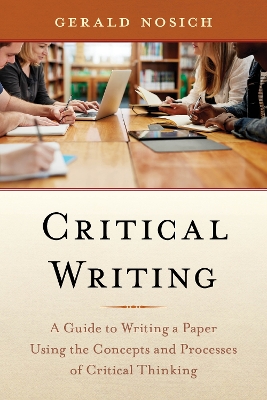The main goal of Critical Writing is to provide students with a set of robust, integrated critical concepts and processes that will allow to them think through a topic, and then write about it, and to do so in a way that is built on, and permeated by, substantive critical thinking. The "topic" in question can be virtually anything that can be written about: issues, situations, problems, questions, arguments, and decisions are just some examples. The critical thinking tools and concepts are built on the Paul-Elder Approach to critical thinking.[1]
A major part of the goal of the book is to provide not only the "what" of writing a paper, but the "how" of it. The "what" is constituted by the essential components of a well-thought-out paper: thesis statement and main points, an articulated structure, development, research, the need for clarity, grammatical correctness, and several others.
Addressing the "how" of these occupies a significantly greater part of Critical Writing. The aim throughout is to show:
- how you can actually construct a thesis statement and the other main points that constitute the structure of the paper;
- how you can write the actual paragraphs that make up the body of the paper;
- how you can engage in productive research and do so in a planned, self-directed way;
- how you can make a point clear-not just grammatically or stylistically clear, but clear in thought and clear in communicating that thought to an audience;
- how you can think your way through the numerous unanticipated issues (including aspects of grammatical correctness, transitions, as well as many others) that arise in the course of writing papers.
The book aims to provide close and careful processes for carrying out each of these, always through the use of one's best reasoned judgment-through critical thinking.
A closely related goal in the book is to bring in the standards of critical thinking. A well-thought-out paper needs to be clear, accurate, relevant, and fair; it needs to stress the important parts of a topic (rather than the minor side-issues); it should be as precise, deep, broad, and sufficient as it needs to be for the context in which the paper is written. But recognizing that these standards are essential is plainly not enough. With the critical thinking standards, the "how" is again paramount. Critical Writing provides concrete usable ways for students to make their paper more accurate, more relevant, and so forth, and to communicate its accuracy, relevance, and the rest to the writers' audience. Perhaps just as important, the book gives specific prompts that help to direct writers toward the thinking required to help them meet those standards.
The specific focus in the book is on writing a paper, but the concepts and processes of critical writing apply in a direct and useful way to virtually any kind of non-fictional writing.
[1]Critical Writing: A Guide to Writing a Paper Using the Concepts and Processes of Critical Thinking lays out the main dimensions of the Foundation for Critical Thinking's articulation of critical thinking (www.criticalthinking.org) as they apply to writing. The approach was developed by Richard Paul, Linda Elder and myself. Probably the best overview of it is contained in Paul and Elder's Critical Thinking: Concepts and Tools. Though Paul and Elder's book is highly condensed, it spells out the essential components of a robust conception of critical thinking.
- ISBN10 153814090X
- ISBN13 9781538140901
- Publish Date 17 March 2021 (first published 12 March 2021)
- Publish Status Active
- Publish Country US
- Imprint Rowman & Littlefield
- Format Hardcover
- Pages 296
- Language English
